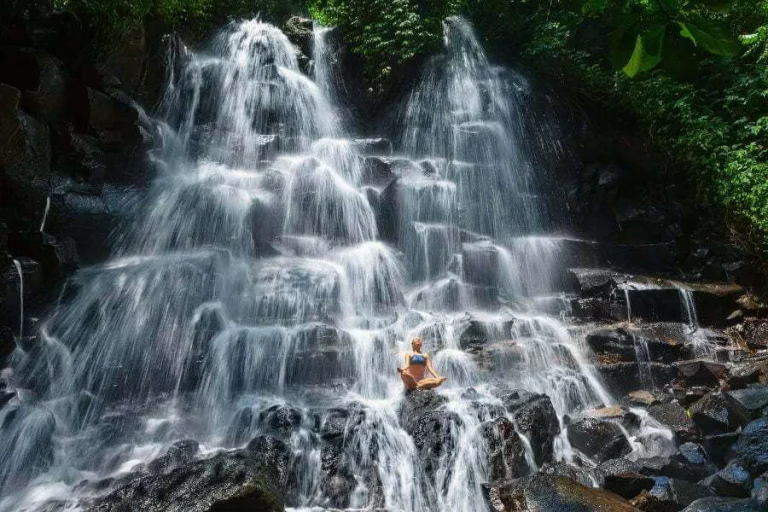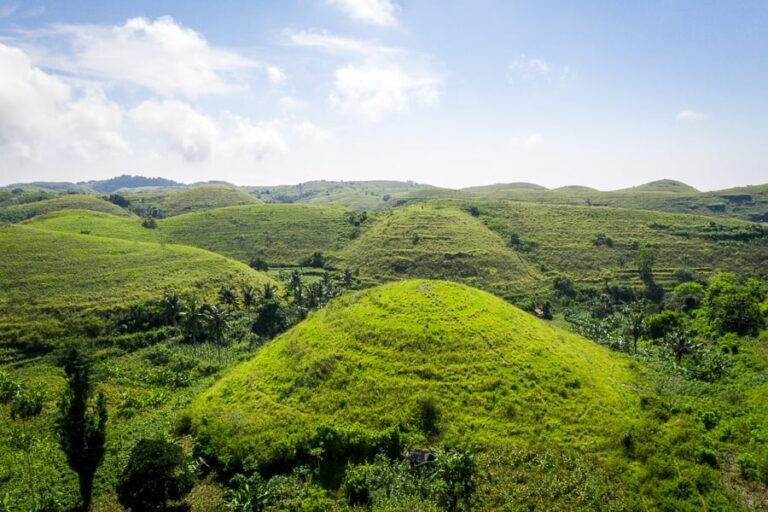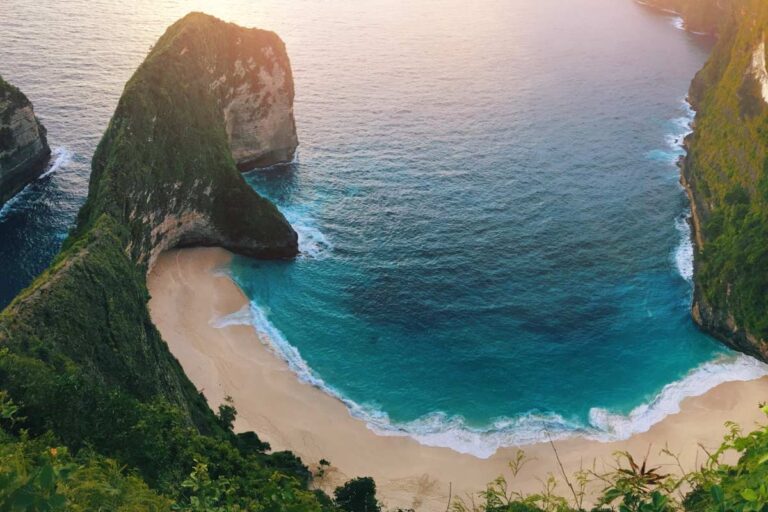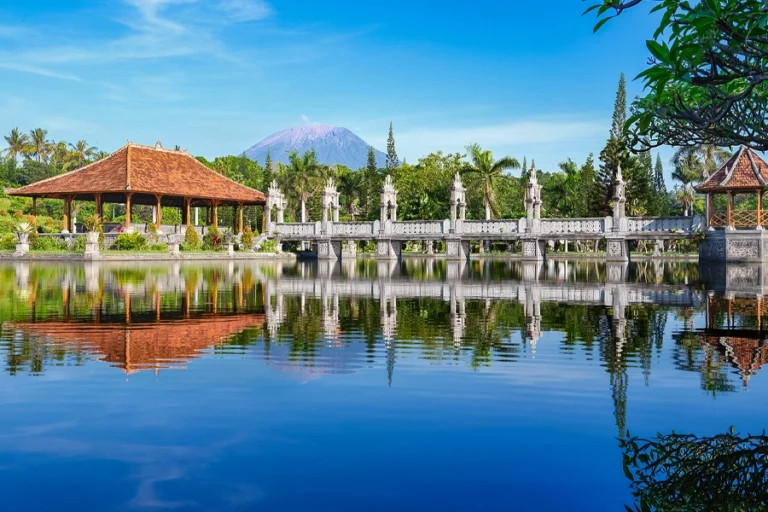Located in the heart of Semarapura, the capital of Klungkung Regency in East Bali, Kertha Gosa—locally known as Taman Gili Kertha Gosa—is a historical landmark and part of the Puri Semarapura royal palace complex. This iconic site features two main structures: the Bale Kertha Gosa, a traditional open pavilion known for its intricate ceiling paintings, and the Bale Kambang, a “floating” hall surrounded by a lotus-filled moat.
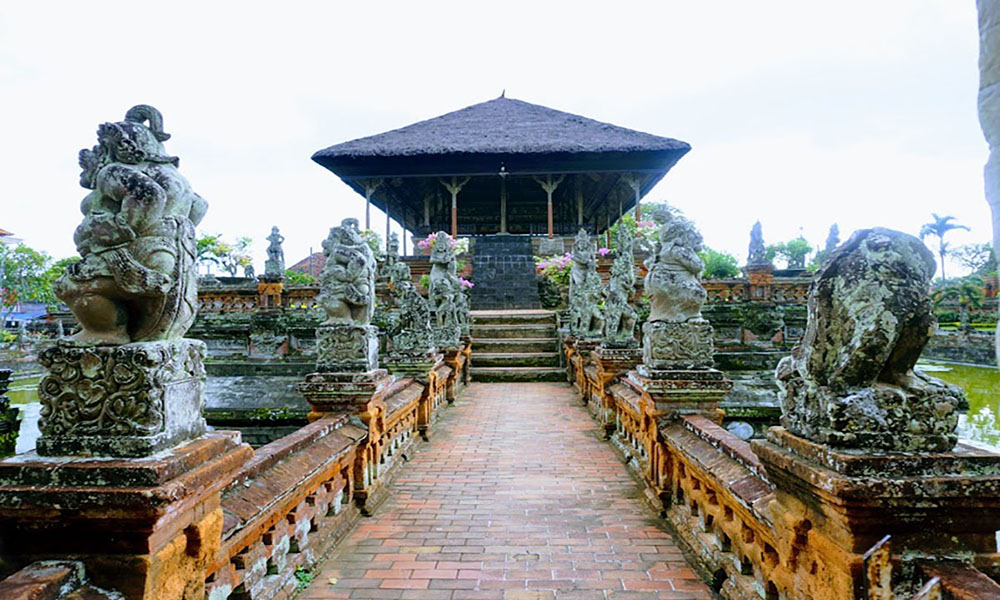
Address & Accessibility
Located in the heart of Semarapura, the capital of Klungkung Regency in East Bali, Kertha Gosa—locally known as Taman Gili Kertha Gosa—is one of the island’s most important historical landmarks. Part of the Puri Semarapura royal complex, it features two distinct pavilions: the Bale Kertha Gosa, known for its story-filled ceiling paintings, and the Bale Kambang, a picturesque “floating” hall surrounded by a lotus-filled moat.
How to Get to Gunung Kawi Temple
Kertha Gosa is in downtown Semarapura, the capital of Klungkung Regency in East Bali. It is about 40 kilometers from Denpasar and easily accessible by car, motorbike, or through a guided tour.
By Car or Private Driver
The most direct route from Denpasar or Sanur is via the Bypass Prof. Dr. Ida Bagus Mantra, with a travel time of approximately 1 to 1.5 hours. Hiring a private driver is a convenient option, especially if you’re including other nearby attractions in your itinerary. Many East Bali tour packages include Kertha Gosa as a stop.
By Motorbike
Travelers who prefer independence can rent a motorbike and enjoy the scenic drive to Semarapura. The journey takes around 1 to 1.5 hours from Denpasar or Ubud. Make sure to wear a helmet and carry a valid international driving permit.
By Taxi or Ride-Hailing App
Taxis are available but may not use meters, especially outside tourist areas. Ride-hailing apps such as Grab and Gojek operate in Bali, though service in Klungkung may be limited. It’s advisable to pre-arrange a round-trip fare.
By Public Transportation
Public transport is limited. Local bemos (minivans) operate between some towns, but they are slow, irregular, and not ideal for tourists unfamiliar with local systems. This option is not recommended for most visitors.
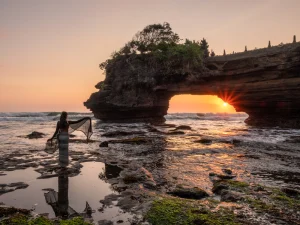
15 Best Things to Do in Bali (2025 Guide)
Bali, also known as the Island of the Gods, is a destination that offers a perfect blend of culture, adventure, and natural beauty. From sacred temples and lush rice terraces to thrilling adventures and serene beaches, here are the 15 best things to do in Bali for an unforgettable trip.
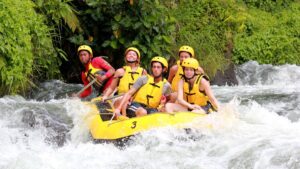
Bali Adventure Tours – Thrills Await in Paradise
Get ready to ignite your adventurous spirit with our Bali Adventure Tours! From conquering the summit of Mount Batur at sunrise to white-water rafting through lush jungles, ATV rides across scenic villages, and snorkeling in crystal-clear waters, our tours are designed for adrenaline seekers and nature lovers alike. With expert
Opening Hours
Gunung Kawi Temple is open to visitors daily from 7:00 AM to 6:00 PM. These hours provide plenty of time to explore the temple complex, admire the intricate rock-cut shrines, and enjoy the peaceful natural surroundings.
For a quieter and more reflective visit, it’s best to come early in the morning or later in the afternoon, when there are fewer tourists.
The temple remains open 24 hours for religious worship, allowing local devotees to perform prayers and rituals at any time. During special Balinese Hindu ceremonies or festivals, some areas of the temple may be reserved for worship. Visitors are kindly asked to be respectful during these sacred events.
Best Time To Visit
The ideal time to visit Gunung Kawi Temple is during Bali’s dry season, which spans from April to October. During these months, the weather is typically warm and dry, with lower humidity and minimal rainfall — perfect for exploring the temple grounds and enjoying the scenic rice terraces and lush green valley.
For a more tranquil experience, it’s best to visit early in the morning between 7:00 AM and 9:00 AM, when the temple is less crowded and the soft morning light brings out the details of the ancient stone carvings. Another great time to visit is in the late afternoon, when the heat subsides and many tour groups have already departed.
If you’re interested in Bali’s rich culture, consider visiting during a Balinese religious festival. While parts of the temple may be reserved for local worshippers, it’s a special opportunity to witness the spiritual and ceremonial life of the island in action. Be respectful and follow temple guidelines during these sacred occasions.
What to See & Do

1. Admire the Kamasan-Style Ceiling Paintings
The highlight of Kertha Gosa is the elaborately painted ceilings inside the open pavilions. Created in the traditional Kamasan style, these paintings depict scenes from Hindu epics like the Ramayana, Mahabharata, and Sutasoma. They illustrate moral and spiritual teachings, including karma, reincarnation, and the journey to Nirvana. Take your time to observe the details—each panel tells a story with symbolic meaning.
2. Explore the Bale Kambang (Floating Pavilion)
Surrounded by a lotus-filled moat, the Bale Kambang is a serene and photogenic structure that seems to float on water. Cross the bridge guarded by stone statues representing characters from the Sutasoma epic and step into a space that once hosted royal ceremonies and spiritual rites.
3. Experience Traditional Balinese Architecture
Walk through the complex and admire the traditional Balinese design, from carved sandstone gates and pavilions to ornamental statues and garden layouts. The layout reflects the principles of Balinese cosmology, blending spiritual and practical elements in every detail.
4. Visit the Puputan Klungkung Monument
Just across the street from Kertha Gosa, the Puputan Monument commemorates the 1908 battle between the Klungkung kingdom and Dutch colonial forces. The monument includes a diorama gallery inside, depicting the bravery and sacrifice of the Balinese people. It adds historical depth to your visit and complements what you learn at Kertha Gosa.
5. Learn About Balinese Justice and History
Originally used as a court of justice, Kertha Gosa offers insight into Bali’s pre-colonial legal system and the role of spiritual law in governance. Many tours or on-site guides can explain how justice was administered, often with reference to the teachings depicted in the ceiling art.
6. Photography and Cultural Appreciation
The complex is an excellent location for cultural photography. From the reflective moat and ancient architecture to the intricately painted ceilings, Kertha Gosa offers many angles for capturing the essence of Balinese history and art.
7. Combine with Nearby Attractions
Many travelers combine a visit to Kertha Gosa with other nearby sites in Klungkung and East Bali, such as Goa Lawah Temple, Kusamba Beach, or Tenganan Traditional Village.
History of Kertha Gosa

Kertha Gosa was established in 1686 during the reign of Dewa Agung Jambe, the first king of the Klungkung Kingdom. As part of the Puri Semarapura royal palace complex, it served as a key venue for royal judicial proceedings, religious ceremonies, and rites of passage for the Balinese nobility.
Originally functioning as a court of justice, Kertha Gosa was where kings and priests presided over legal matters, including civil and spiritual disputes. The location’s very name—Kertha Gosa—reflects its purpose: “Kertha” meaning peace or prosperity, and “Gosa” meaning discussion or deliberation. Together, they imply a place of wise counsel and judgment.
During the Dutch colonial occupation from 1908 to 1942, Kertha Gosa continued to serve as a courthouse, but under colonial administration. This period marked a shift in its function from royal governance to colonial authority, though much of its traditional structure and spiritual atmosphere was preserved.
Over the centuries, the site experienced deterioration, prompting several restoration projects, including major efforts in 1930 and 2014, to preserve its architecture and the iconic Kamasan-style ceiling paintings. These paintings not only beautify the site but also served an educational and moral function—depicting stories from Hindu epics to guide those who stood trial.
Today, Kertha Gosa stands as one of Bali’s most important cultural and historical landmarks, reflecting the island’s blend of spirituality, governance, and artistry. It remains a testament to the island’s royal legacy and enduring traditions, attracting visitors seeking a deeper understanding of Bali’s heritage.
Know Before You Go
Dress Code
There is no strict dress code, but modest attire is appreciated. As it is a historical and cultural site, wearing respectful clothing—covering shoulders and knees—is encouraged.
Guided Tours
Local guides are sometimes available on-site. While not required, a guide can enhance your visit by explaining the stories depicted in the ceiling paintings and the site’s royal history.
Best Time to Visit
Visit in the morning or late afternoon for cooler temperatures and softer lighting—ideal for photography. Weekdays are usually less crowded than weekends.
Facilities
Parking: Available nearby, including space for cars and tour buses.
Restrooms: Public toilets are available near the entrance, though they may be basic.
Shops & Stalls: Small souvenir stalls and snack vendors are often found outside the complex.
Accessibility
The site is generally flat and easy to walk, but some surfaces are uneven. Wheelchair access is limited, particularly in older sections and around the moat.
Photography
Photography is allowed throughout the site. Flash is discouraged around the painted ceilings to preserve the artwork.
Nearby Attractions
Combine your visit with other Klungkung landmarks, such as the Puputan Klungkung Monument, located directly across the street, or other East Bali destinations like Goa Lawah Temple and Tenganan Village.
By keeping these tips in mind, your visit to Kertha Gosa will be more comfortable, respectful, and enriching.

